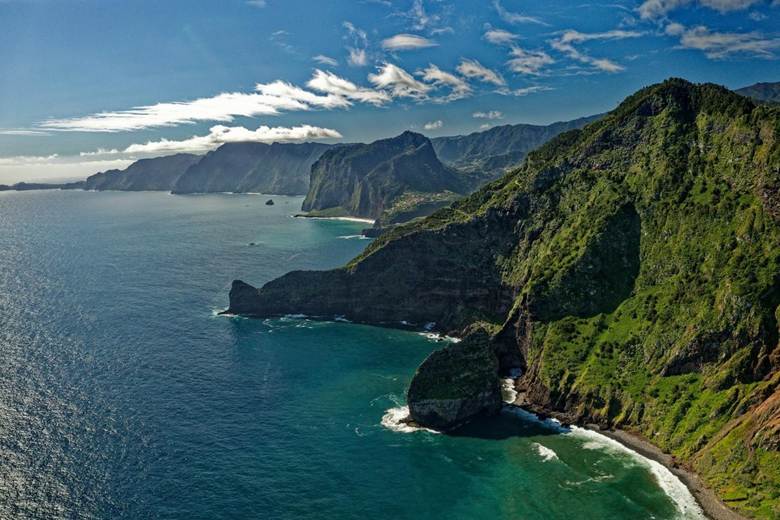(Colin Watts/Unsplash)
Truth be told, Madeira might just be one of the best-kept secrets of the Atlantic. Known for its striking cliffs, lush gardens, and endless hiking trails, it also offers something that keeps visitors coming back year after year: a remarkably pleasant climate.
Indeed, the Madeira climate is famously mild and consistent, making the island an idyllic destination whether you’re chasing winter sun, spring blooms, or a late summer escapade.
If you’re planning a trip and wondering what to expect from the weather, here’s your ultimate guide to the island’s seasons, temperatures, rainfall, and everything in between.
An Overview of Madeira’s Climate
Thanks to its location just off the northwest coast of Africa and the influence of the Gulf Stream, Madeira enjoys a subtropical climate with spring-like conditions throughout the year.
Temperatures rarely drop below 15°C in the winter or rise above 27°C in the summer. Rainfall is seasonal, but even during wetter months, sunny days are never far away.
The island’s unique geography, comprising mountains, valleys, and coastlines, creates microclimates, allowing you to often find sunshine even if it’s raining a few miles away.
Madeira Weather by Season
Winter (December to March)
Winters in Madeira are comfortably mild. Days are typically in the 20°C range, while nights stay around 14°C. You’ll get a bit more rain during this period, especially in January, but it tends to come in quick showers.
There’s still plenty of sun, though, making this a great escape for those coming from colder parts of the world.
Spring (March to June)
Spring is one of the most beautiful times of the year on the island. Temperatures climb to around 20°C, the air feels fresh, and Madeira’s gardens burst into bloom.
Rain becomes less frequent, and sunny days are the norm. It’s the perfect season for exploring the levadas, botanical parks, and outdoor cafés.
Summer (June to September)
While summer brings the warmest days, Madeira doesn’t experience the sweltering heat of mainland Europe. Highs generally span an average of 25°C, accompanied by refreshing breezes from the Atlantic.
Rain is rare, skies are clear, and daylight hours are long. In short, this is the ideal combination for beach lovers, hikers, and anyone looking for that golden-hour glow.
Fall (September to December)
Fall is often overlooked, though it is absolutely stunning. September is still warm and dry, with sea temperatures at their peak.
As the season progresses, rainfall gradually returns, especially in November, but daytime temperatures remain very comfortable, making it a wonderful opportunity to enjoy the island’s natural beauty with fewer crowds.
Temperature Ranges Throughout the Year
Madeira experiences a stable range of temperatures all year long. Winters are mild enough for outdoor activities, while summers never become uncomfortably hot.
This blend of climatological circumstances makes it easy to plan your itinerary without worrying too much about the forecast, which means that you’ll likely be comfortable in light layers, whether you’re visiting in February or July.
Rainfall Patterns and Wet Season Insights
Rainfall in Madeira is concentrated primarily during the winter months, specifically between November and February. January typically sees the most rain, but even then, it’s often short and sharp rather than long and dreary.
The island’s mountains attract more moisture, meaning the north and interior tend to be wetter than the southern coast. In contrast, from May to September, rainfall is minimal, especially in areas such as Calheta or Ponta do Sol.
Sunshine Hours and Daylight Variations
Madeira offers a generous amount of sunshine throughout the year. In the summer, you can enjoy up to eight hours of sun a day, while even in the winter months, you’ll typically get five to six hours of daylight.
Spring and fall drop comfortably in between. If you’re staying along the south coast, particularly around Funchal or Câmara de Lobos, you’ll find these areas tend to get the most reliable sunshine thanks to the island’s topography.
Ocean Temperature and Swimming Conditions
One of the island’s biggest perks? The ocean stays warm enough to swim in almost all year. In the summer, water temperatures typically reach around 24°C, and even in the winter, they rarely fall below 18°C.
September is especially charming for swimming, with calm seas and balmy water. You’ll find swimming conditions inviting, whether you prefer natural lava pools, sandy beaches, or hotel infinity pools.
Best Months to Visit Madeira for Good Weather
If your top priority is the weather, the sweet spot runs from July through September. These months offer the warmest temperatures, clearest skies, and perfect conditions for both hiking and relaxing by the sea.
That said, April to June is equally delightful and often less crowded, with vivacious flowers and mild conditions. Even in the winter, Madeira provides a sunnier, warmer alternative to much of Europe and North America, making it a top off-season pick.
Weather Differences Between Funchal and the Mountains
Funchal, the capital, sits on the south coast and enjoys some of the island’s best weather; it’s warmer and drier than the northern or mountainous regions.
If, however, you’re heading inland or planning to explore peaks like Pico do Areeiro or Pico Ruivo, be prepared for cooler temps and potentially misty conditions.
The difference can be dramatic—warm sunshine at sea level, and brisk, cloudy air just a few miles inland.
What to Pack for Each Season in Madeira
Because Madeira’s climate is so varied, smart packing is all about layering:
- In the winter, bring light jackets, a sweater, and a waterproof layer;
- For spring and fall, breathable clothes for the day and a light sweater for the evenings are perfect;
- In the summer, you’ll be fine with T-shirts, shorts, swimwear, and a light outer layer for breezier nights or mountain trips.
Additionally, regardless of when you visit, comfortable walking shoes are essential, especially if you plan to explore the trails.
How the Climate Affects Local Events and Festivals
Madeira’s weather doesn’t just shape your travel wardrobe; it also sets the tone for its colorful calendar of events:
- In the spring, the Flower Festival celebrates the island’s lush beauty with parades and floral displays;
- Summer is all about the Atlantic Festival, where fireworks light up the sky;
- Come late summer, the Wine Festival kicks off in honor of Madeira’s famous vintages;
- Even the winter is festive, with dazzling holiday lights and one of Europe’s most impressive New Year’s Eve fireworks shows.
In Short
What makes the Madeira climate so special is its consistency and comfort; you don’t have to plan your trip around avoiding extreme heat or bitter cold.
Whether you’re after outdoor adventures, beach lounging, cultural festivals, or all of the above, Madeira welcomes you with open skies and pleasant temperatures almost every day of the year.
So, whenever you’re ready to escape the ordinary, pack your bags and come experience a destination where the weather is always on your side.



